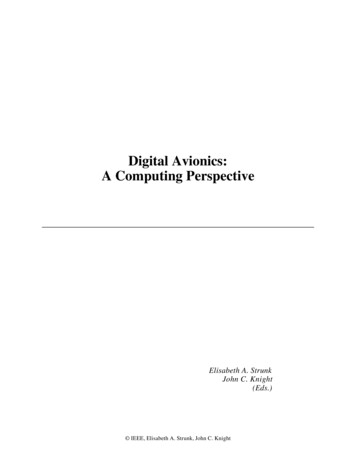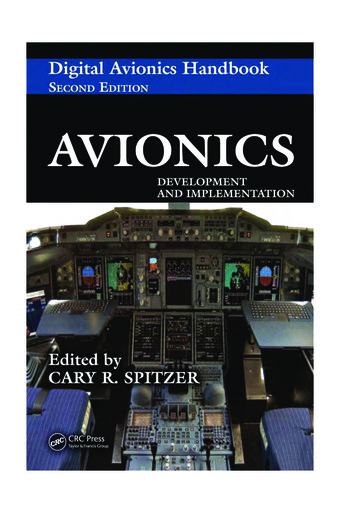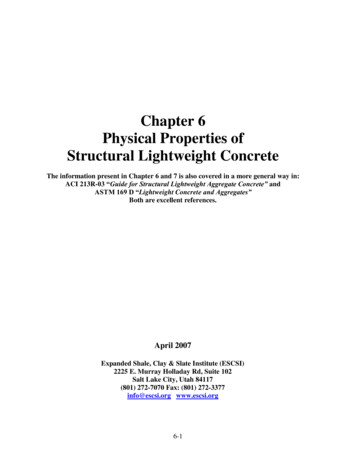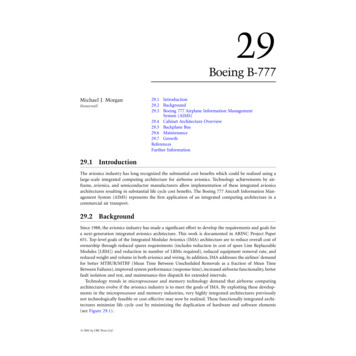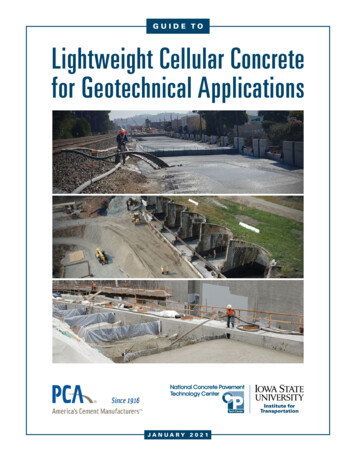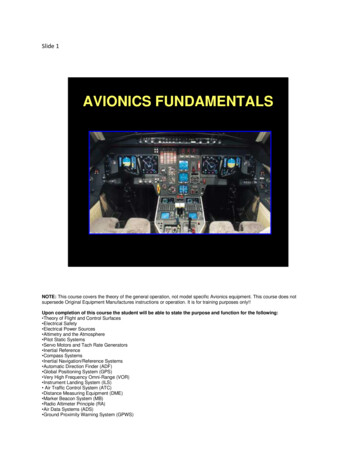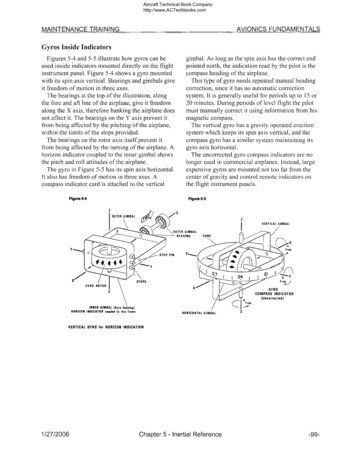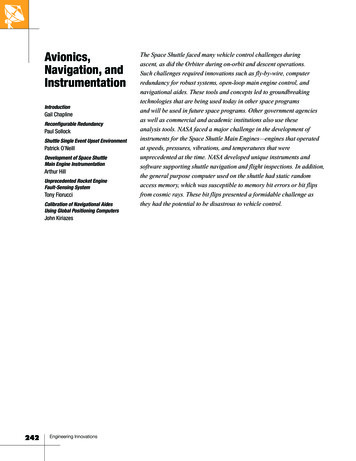
Transcription
CRANFIELD UNIVERSITYMICHAEL F BESSANTLIGHTWEIGHT AVIONICS PLATFORM TO ACCESSATMOSPHERIC ENVIRONMENTAL SCIENCESCHOOL OF ENGINEERINGMSc BY RESEARCH THESISAcademic year: 2012-2014Supervisor: David C CullenOctober 2014
CRANFIELD UNIVERSITYSCHOOL OF ENGINEERINGMSc BY RESEARCH THESISAcademic Year: 2012-2014MICHAEL F BESSANTLightweight Avionics Platform to Access Atmospheric Environmental ScienceSupervisor: David C CullenOctober 2014 Cranfield University, 2014. All rights reserved. No part of this publication maybe produced without the written permission of the copyright holder.
ABSTRACTThere is a region of the atmosphere between approximately 10-40 km above the Earth’ssurface that is inaccessible to most winged aircraft and that rockets visit only fleetingly,but where small unmanned balloons are increasingly being used to carry lightweight( 5 Kg) scientific payloads. A major disadvantage of using these inexpensive ‘weather’balloons is that researchers often have to develop telemetry and support avionics inaddition to the core experiment. The aim of this thesis project was to significantlyreduce this challenge by developing a Lightweight Avionics Platform (LAP) that wouldbe able to support a wide range of experiments by providing data from a suite of sensorsand a GPS receiver, together with an Iridium satellite link for communicating withinternet enabled ground stations. The LAP also provides non-volatile storage for thesensor, GPS and experiment generated data.The LAP design is based on a low power consumption microcomputer that iscompatible with the Arduino Integrated Development Environment (IDE) and itsassociated open-source communication and sensor interface libraries. Modular systemsarchitecture was employed as an aid to rapid hardware development. A major designgoal was to allow researchers to interface their experiments without affecting theintegrity of the LAP’s embedded operating software. A dedicated Science Interface Port(SIP) is provided for this purpose that allows experiments to be powered and dataexchanged, via a single electrically robust connector. This part of the project wascompleted with the construction and testing of a flight-capable LAP that weighs lessthan 0.2 Kg.In order to ascertain the reliability of the above platform when subjected to the lowtemperatures and pressures expected during stratospheric flight, the project included thedevelopment of an environmental test chamber and associated monitoring/loggingsystem. A unique feature of this low cost chamber is that it is both portable andtransparent to satellite communications’ signals. Finally, design details for a proposedatmospheric dust sampling experiment are provided as an example LAP application.i
ACKNOWLEDGEMENTSWith grateful thanks for the enthusiastic help of my supervisor, Prof. David Cullen, andthe unstinting support and advice from my familyii
CONTENTSABSTRACT . iACKNOWLEDGEMENTS . iiCONTENTS . iiiLIST OF FIGURES . viACRONYMS. ix1. INTRODUCTION .12. PRESENT STATE OF TECHNOLOGY .32.1 High Altitude Atmospheric Research Vehicles .32.1.1 Rockets .32.1.2 Winged Aircraft.32.1.3 Large Zero-pressure Balloons .42.1.4 Super-pressure Balloons .52.1.5 Extensible Latex Balloons .72.1.6 Latex Balloons: Research Applications .93. AIMS AND OBJECTIVES . 114. IMPLEMENTATION AND REFINEMENT . 144.1 LAP Microcontroller . 154.2 Watchdog Recovery. 164.3 The I2C Bus . 214.4 Serial Communications . 224.5 Analogue to Digital Converter . 234.6 Sensors . 244.6.1 External Temperature . 244.6.2 Relative Humidity . 254.6.3 Pressure and Internal Temperature . 28iii
4.6.4 Magnetometer . 294.6.5 GPS Receiver . 304.6.6 GPS Receiver Simulator. 334.6.7 Balloon Cut Down Switch . 344.7 On-board Data Storage . 354.8 Satellite Communications. 374.9 Science Interface Port (SIP) . 405. ENVIRONMENTAL TESTING . 445.1 Automated Monitoring and logging (AML) System . 455.2 LAP Operating Software for Environmental Tests . 506. ENVIRONMENTAL TEST RESULTS . 536.1 Data Processing . 536.2 Example Plots . 557. FLIGHT PLANNING . 598. FINAL DISCUSSIONS AND CONCLUSIONS. 638.1 Avionics . 638.2 Proposed Revision to External Temperature Sensor Circuitry . 658.3 Proposed Revision to Iridium Transceiver Supply Circuitry . 668.4 Test Equipment and SIP Example . 668.5 Prototype Experiment Controller . 678.6 Payload Gondola Design . 709. FUTURE WORK . 71REFERENCES . 72APPENDICES . 78A RockBlock Connections . 78iv
B SIP Connections . 79C Flight Plan. 80D Embedded Software . 84v
LIST OF FIGURES1: Partially inflated zero pressure balloon before launch of the CASS-Epayload (D.Cullen) . 42: Super-pressure pico balloon made from heat sealed mylar sheets (L.Bodnar) . 63: Cambridge students prepare to a launch latex balloon carrying a Cranfieldbio-sampling experiment (D.Cullen) . 74: Typical and float flight profiles for latex balloons . 85: Summary of platforms that could be used for atmospheric research . 116: Functional blocks of the Lightweight Avionics Platform (LAP) . 147: Recommended program flow with the watchdog cleared within main loop. 198: Independant watchdog circuit. 209a: Watchdog times out and generates a reset pulse . 209b: Watchdog receives clear input within timing out period and does notgenerate a reset pulse . 2110: Thermistor based external temperature interface . 2511: External humidity interface . 2612: Manufacturers calibration sheet for the relative humidity sensor usedduring environmental tests . 2713: Embedded Adventures MOD-1009 pressure/temperature sensor module . 2914: SparkFun Electronics 3-axis magnetometer module . 3015: Revelation Education GPS 010 uBlox receiver module . 3316: LAP compatible GPS simulator module . 3417: MOSFET Cut-down circuit . 35vi
18: SparkFun Electronics OpenLog micro SD card interface module . 3719: Data packet broadcast via the SIP and stored on the SD card . 3720: Example email from Iridium Transceiver Ground Test . 3821: The Rockblock Iridium satellite transceiver board mounted on screenedLAP enclosure . 3922: LAP serial output circuitry to SIP. 4123a: Digital oscilloscope display of waveform at SIP pin 6, for R 3.3 Kohm . 4323b: Digital oscilloscope display of waveform at SIP pin 6, for R 15 Kohm. 4324: Overview of Automatic Monitoring and Logging (AML) System . 4525: Scrolling StampPlot display from pressure test at ambient temperature . 4726: Automatic Monitoring and Logging (AML) wiring schematic . 4827: LAP, Distribution Box and GPS antenna in pressure vessel, with externalBreakout Board . 4928: Fully functional LAP board being removed from thermal chamber after -36C soak test. 4929: Logic State Analyser display of two main program loops . 5230: Raw LAP sensor data sampled at 1 Hz . 5431: Decreasing temperature at ambient pressure . 5632: Decreasing pressure and temperature . 5633: Decreasing pressure with increasing temperature . 5734: Decreasing pressure at ambient temperature . 5735: Photo of Lightweight Avionics Platform (LAP) . 6336: Schematic of Lightweight Avionics Platform (LAP) . 64vii
37: Proposed external humidity and temperature board . 6538: Revised regulator for Rockblock supply . 6639. Prototype SIP compatible controller for Dust Sampling Experiment (DSE) . 6940. Wiring of actuators for proposed DSE . 69viii
gue to Digital ConverterAutomatic Monitoring and LoggingAmerican Standard Code for Information InterchangeAttention ModemBalloon Experiments for University StudentsCivil Aviation AuthorityCranfield Astrobiological Stratospheric Sampling ExperimentCalifornian Near Space ProjectComma Separated ValuesCambridge University Space FlightDust Sampling ExperimentElectrically Erasable Programmable Read Only MemoryFile Allocation TableField Effect TransistorGlobal Horizontal Sounding TechniquesGlobal Positioning SystemHigh Altitude Student PlatformInter-Integrate CircuitInternational Business MachinesIn Circuit ProgrammerIntegrated Development EnvironmentLightweight Avionics SystemLow Earth OrbitLaser Imaging Detection and RangingLogic State AnalyserMetal Oxide On Silicone Field Effect TransistorMicroSoftNational Aeronautics and Space AdministrationNational Marine Electronics AssociationNotice to AirmanNegative Temperature CoefficientOriginal Engineering ManufacturerPersonal ComputerPulses Per SecondProgrammable Read Only MemoryResistor CapacitorRocket Experiments for University StudentsRelative HumidityReduced Instruction Set ComputingRemotely Piloted VehicleResistive Temperature DetectorReceive DataShort Burst DataSignal ClockSatellite Communications PortSecure DigitalSignal DataSystems HarnessScience Interface PortSub Miniature AStatic Radom Access MemoryTransmit DataUnited KingdomUniversal Serial BusExtruded Polystyrene Foamix
1. INTRODUCTIONOf the many areas of atmospheric research, dust transportation, is particularlyrelevant to human health whether directly by disease transmission or indirectly byimpacting nutrition. An increasing number of scientists are beginning toappreciate the influence that escalating amounts of atmospheric dust are having onclimate and on ocean and forest fertilization [1]. The majority of airborne soil andmineral dust present in the Northern Hemisphere is produced in Africa andtransported, in plumes hundreds of kilometres wide, to land on the other side ofthe Atlantic. The number of publications on the subject of Saharan dust alone hasrisen sharply since the 70s [2]. Much of the early research relied on ground-basedLIDaR (Laser Imaging Detection and Ranging) [3] with remote satelliteobservation making a growing contribution [4]. Data from remote sensingplatforms are often complemented by in-situ measurements that are made from arange of atmospheric vehicles, including unmanned balloons [5]. At the altitudesof interest, balloons are uniquely efficient platforms from which to undertake insitu dust measurements and collection.An illustration of the important contribution balloon-borne instruments can maketo science relates to the influence that electrical charge has on dust particles.Remote sensing observation has repeatedly detected the transportation of large(8μm) particles over significantly greater distances than had been predicted byatmospheric models that had assumed randomly aligned particles. This anomalywas recently explained when in-situ measurements showed that the influence ofelectrical charge can cause dust particles to become predominantly verticallyaligned and larger ones effectively levitated within a dust plume, beyond the pointwhere existing models had predicted gravitational settling [6]. A similarmechanism has been shown to affect the transportation of electrically chargedvolcanic ash [7]. It is interesting to note that such a fundamental discovery wasmade possible with the aid of small disposable ‘weather’ balloons and lightweightpayloads that cost only hundreds of pounds to launch [8]. In order to better exploitthese low cost research tools, it was proposed to develop a lightweight avionics1
platform that could support a range of scientific experiments and this will be thesubject of this thesis.2
2. PRESENT STATE OF TECHNOLOGYThree types of vehicle that provide access to high altitudes are: rockets, wingedaircraft and balloons. The following brief comparison of these technologiessummarises the unique advantages that balloons offer in many areas ofatmospheric research. The three main balloon technologies are described togetherwith example research applications.2.1 High Altitude Atmospheric Research Vehicles2.1.1 RocketsSounding rockets are an established high altitude research tool. One example usedby researchers and students is the REXUS unguided solid fuel rocket [9]. It is ableto carry a payload to a maximum altitude of over 90 km, but offers only a fewminutes of experiment time. The high speeds reached during ballistic flight canmake the integration of some types of instrument an aerodynamic challenge [10].Additional payload design constraints include having to withstand rapidtemperature and pressure changes together with high levels of acceleration andvibration. Therefore the entire development process requires access to a widerange of specialised test facilities. Sounding rockets may often be a prohibitivelyexpensive means of undertaking research at altitudes that can be more easilyaccessed by the vehicles described below.2.1.2 Winged AircraftAt the time of writing the highest altitude reached by a winged aircraft is 29 km.The NASA Helios remotely piloted vehicle (RPV) managed to maintain thisaltitude for 40 minutes during its maiden flight but disintegrated early into thesecond flight [11]. A more practical vehicle for stratospheric sampling is themanned NASA ER-2 version of the Lockheed U2 reconnaissance aircraft, whichis able to cruise at altitudes of over 20 km [12]. However, research projects thatrequire routine access must rely on commercial jet aircraft that normally operateat altitudes of less than 10 km but even their use for monitoring/collecting sample3
materials, e.g. volcanic ash and radioactive particles, may be prohibited on safetygrounds.2.1.3 Large Zero-Pressure BalloonsFigure 1: Partially inflated zero pressure balloon before launch of the CASS-E payload(D.Cullen)A zero-pressure balloon, of the type shown by Figure 1, is usually fabricated ofpolyethylene and designed to attain specific altitudes. When the expanded gas hasextended the envelope to its maximum size the gas is vented to prevent bursting.The largest zero-pressure balloons can be up to 17 million cubic metres in volumeand lift 1,000 kg payloads to an altitude of 45 km. A near constant altitude can bemaintained, for several hours or days, by releasing ballast to compensate forreduced lift after sunset. These unmanned flights are primarily undertaken onbehalf of scientists to transport a single heavy instrument (e.g. cosmic ray4
detector) into the stratosphere [13]. However, a number of zero-pressure balloonprogrammes are specifically aimed at providing teams of university students witha practical and low cost means to fly their experiments. The main feature thatthese programmes have in common is the use of a flight proven avionics platformthat can support multiple instrument payloads. The example described below isthe joint Louisiana State University/NASA High Altitude Student Platform(HASP) zero-pressure balloon programme [14].The HASP platform currently supports eight small (3 kg) and four large (20 kg)student payloads. A standard interface port is provided for each payload thatprovides power supplies, serial communications and discrete input/output lines.HASP is able to archive payload data on-board as well as transmitting to a groundstation via a radio telemetry link. The telemetry data rate for small and largepayloads is 1200 bps and 4800 bps respectively. Radio commands issued by theground station are able to control discrete output lines on individual payloads. TheHASP-Student Payload Interface Manual [15] includes information on thediscrete interface lines and serial communications protocol to aid the developmentof experiments.Such large balloons require extensive ground support facilities and the weight offully populated avionics platforms restricts the areas where they can be safelylaunched, flown and recovered. These operational limitations, together with thenumber of participants involved, can lead to up to a year elapsing between NASAissuing a ‘Call for Payloads’ and the actual flight.2.1.4 Super-pressure BalloonsSuper-pressure balloon technology enables long duration flights at apredetermined altitude without recourse to flight duration limiting gas and ballastexpenditure. This is achieved by constructing a sealed envelope from material thatis less yielding than that used by zero-pressure balloons. A super-pressureballoon’s internal gas expands during ascent until the limit of the envelope’sdisplacement is reached and a float condition is established. This is normally at alower altitude than the maximum reached during zero-pressure and extensible5
balloon flights. Changes in temperature mainly affect the balloon’s internalpressure, whilst displacement remains relatively stable and a near constantatmospheric density altitude can be maintained over many diurnal cycles. Forexample, a super-pressure balloon, launched in 1968 as part of the US Air Force’sGlobal Horizontal Sounding Technique (GHOST) research programme [16],repeatedly circumnavigated the southern hemisphere during a flight lasting overtwo years. More recently, a small ( 0.2 cu m) super-pressure balloon, similar tothe one shown in Figure 2, was launched from the UK on the 12th July 2014 andcircumnavigated the northern hemisphere three times in 59 days at anapproximate altitude of 12 km whilst carrying an 11 gram solar powered GPSreceiver and radio transmitter.Figure 2: Super-pressure pico balloon made from heat sealed mylar sheet s(L.Bodnar)6
2.1.5 Extensible Latex BalloonsFigure 3: Cambridge students prepare to a launch latex balloon carrying a Cranfield biosampling experiment (D.Cullen)An extensible latex balloon, shown in Figure 3, has an envelope that typicallycontains a few cubic metres of helium (or less commonly hydrogen) and is usuallymade of latex. When released these balloons normally rise and expand untilbursting. They are routinely used by meteorologists to carry radiosondeinstruments, weighing a few hundred grams, into the stratosphere to obtainvertical profiles of atmospheric conditions. This type of balloon is variouslyreferred to as ‘weather’, ‘sonde’ or ‘latex’ (only the latter will continue to be usedin this document). Many thousands of disposable meteorological radiosondepayloads are released throughout the World each year and this has led to latexballoons becoming low cost commodity items. They are available in a range ofsizes/weights having different lift capacity and burst diameters [17]. The typicalflight profile of a 1600 gram balloon and 2 kg payload combination is a 7metres/second ascent to a burst altitude of over 32 km, within about 80 minutes7
[18]. Figure 4 shows typical and extended flight profiles for small latex balloons.The difference in day and night float altitudes is caused by the balloon expandingunder the influence of solar heating.Day floatBurstNight floatParachute descentTypicalFloat (D. Akerman, flight )Figure 4: Typical weather balloon and float flight profiles for latex balloonsAutomatic altitude control systems could be used to extend the flight duration butthe combined weight of ballast and the venting valve would reduce the liftavailable for payloads [19]. However, a simpler passive approach wassuccessfully used in 2012 by the amateur Californian Near Space Project (CNSP)to fly a 1600 gram latex balloon from California to Morocco covering a distanceof 9,804 km in 55 hours at an altitude of approximately 31 km. CNSP claim thisfeat was made possible by proprietary software that predicts the volume of heliumrequired to float a specific balloon/payload combination at a predetermined cruisealtitude [20]. A practical disadvantage of this technique is that the marginal liftrequired to obtain a float condition makes the balloon difficult to handle andvulnerable to ground damage at launch.8
2.1.6 Latex Balloons: Research ApplicationsThe global demand for intelligent mobile products has led to a rapid reduction inthe size and cost of low power electronics, including wireless devices and sensors.The increased availability of these components has enabled research teams toproduce novel scientific instruments specifically designed to be carried by latexballoons [21, 22, 23]. Recent examples include aerosol particle spectrometers andatmospheric electrical charge sensors [24]. Using latex balloons enabled suchinstruments to be deployed in response to the Eyjafjallajokull volcanic eruption of2010 [25].An impediment to rapid balloon deployment in the UK is the need to gain launchpermission from the Civil Aviation Authority (CAA) for balloons that exceed 2metres in any dimension. An application with details of the payload (normallyrestricted to 5kg) and launch location must normally be made 28 days before theevent. If the application is successful the CAA will email permission and alsoissue a NOTAM (Notice to Airmen). Fortunately it is possible to obtainpermanent NOTAM clearance that may allow launches to be undertaken at shorternotice. Cambridge University Spaceflight (CUSF) [26] has a permanent NOTAMfor the Churchill College sports field and they regularly make this launch facilityavailable to other organisations.A further legal constraint involves the use of radio transmitters for telemetry andcommand. No radio equipment may be installed or operated in the UK exceptunder the authority of a licence granted by, or otherwise exempted by, regulationsmade by Ofcom [27]. In practice these restrictions have resulted in the 433 MHzlicense exempt band being used for most airborne telemetry applications in theUK. Even though the maximum permitted output power for this band is only10 mW the inherently good line-of-site conditions offered by balloon platformsenable data to be received over hundreds of kilometres, providing the data rate islimited to a few hundred bits per second (bps) and the ground station is equippedwith a sensitive radio receiver and high-gain antenna.9
One university group avoids the need to set-up and operate ground stations byemploying modified radiosonde transmitters that use the standard meteorologicalreceiving network [28]. However, this approach is only able to monitor a fewchannels at low data rates. At the time of writing few UK operators havedeveloped a legal means of sending commands to latex balloons and thereforethey are not able to remotely control instruments or flight duration.10
3. AIMS AND OBJECTIVESFigure 5: Summary of platforms that could be used for atmospheric researchFigure 5 shows that a region of the Earth’s atmosphere, between approximately10 km to 40 km above the surface, is essentially uninhabitable to all but the mostexotic winged aircraft, and where sounding rockets visit only fleetingly.Unmanned balloons routinely carry payloads into this region on flights that lasthours or even months to provide a relatively economical means of gaininginformation that would otherwise be inaccessible.11
Users of large zero-pressure balloons already have access to established facilitiesin Europe and North America. Examples are the BEXUS and HASP programmesthat provide flight-proven avionics platforms and extensive ground support, buttheir inherently long lead-times and launch/recovery safety considerations make itdifficult for them to be rapidly deployed in response to environmental events.Although the above operational constraints need not apply to latex balloonpayloads of less than a few kilograms, researchers may be obligated to developavionics and ground support facilities in addition to the core experiment.This project aims to reduce this challenge by developing, and environmentallytesting, a Lightweight Avionics Platform (LAP) ( 200g) that will support a widerange of balloon-borne experiments. The availability of this reference LAP designshould allow researchers to concentrate more time on the development and testingof unique experiments. The main tasks required of the LAP are listed below: Acquire GPS position data for tracking Acquire local environment data that may complement the experiment Exchange experiment and local environment data via interface port Transmit avionics and experiment data to a ground station Receive commands from a ground station Store avionics and experiment data on-board Condition battery supply to power the avionics and experiment.The LAP must perform a similar role to the HASP zero-pressure balloon platformbut, due to the smaller lift capacity of latex balloons, it will support a singleexperiment payload. Unlike the heavier and well supported platforms that utiliseradio telemetry, LAP telemetry data will be received, and commands issued froman internet equipped ground station using the commercial Iridium satellitenetwork [29]. This approach will avoid international radio restrictions and theburden of ground station logistics, thus facilitating the rapid global deployment ofatmospheric experiments in response to environmental events.12
Since high altitude balloon payloads must operate reliably when subjected to lowtempera
development of an environmental test chamber and associated monitoring/logging system. A unique feature of this low cost chamber is that it is both portable and transparent to satellite communications' signals. Finally, design details for a proposed atmospheric dust sampling experiment are provided as an example LAP application.

